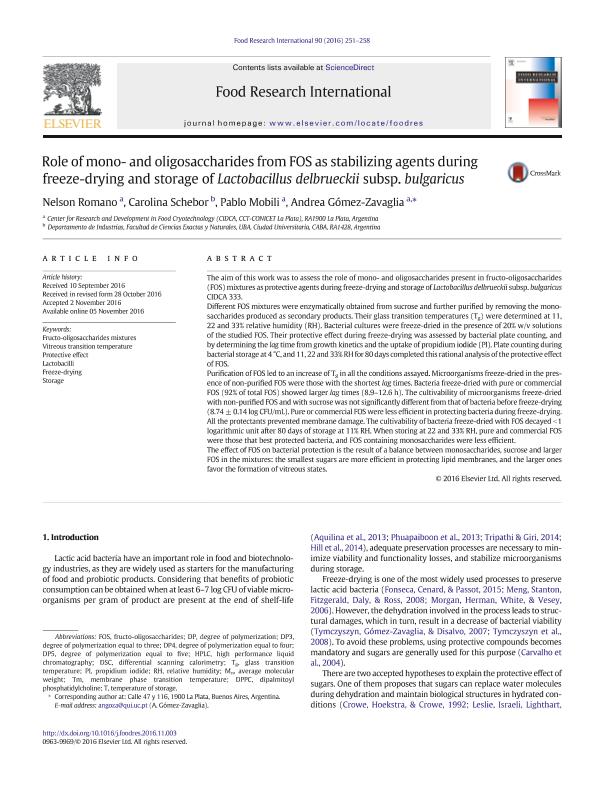Mostrar el registro sencillo del ítem
dc.contributor.author
Romano, Nelson Gastón

dc.contributor.author
Schebor, Carolina Claudia

dc.contributor.author
Mobili, Pablo

dc.contributor.author
Gomez Zavaglia, Andrea

dc.date.available
2018-06-25T21:40:43Z
dc.date.issued
2016-12
dc.identifier.citation
Romano, Nelson Gastón; Schebor, Carolina Claudia; Mobili, Pablo; Gomez Zavaglia, Andrea; Role of mono- and oligosaccharides from FOS as stabilizing agents during freeze-drying and storage of Lactobacillus delbrueckii subsp. bulgaricus; Elsevier Science; Food Research International; 90; 12-2016; 251-258
dc.identifier.issn
0963-9969
dc.identifier.uri
http://hdl.handle.net/11336/50018
dc.description.abstract
The aim of this work was to assess the role of mono- and oligosaccharides present in fructo-oligosaccharides (FOS) mixtures as protective agents during freeze-drying and storage of Lactobacillus delbrueckii subsp. bulgaricus CIDCA 333. Different FOS mixtures were enzymatically obtained from sucrose and further purified by removing the monosaccharides produced as secondary products. Their glass transition temperatures (Tg) were determined at 11, 22 and 33% relative humidity (RH). Bacterial cultures were freeze-dried in the presence of 20% w/v solutions of the studied FOS. Their protective effect during freeze-drying was assessed by bacterial plate counting, and by determining the lag time from growth kinetics and the uptake of propidium iodide (PI). Plate counting during bacterial storage at 4 °C, and 11, 22 and 33% RH for 80 days completed this rational analysis of the protective effect of FOS. Purification of FOS led to an increase of Tg in all the conditions assayed. Microorganisms freeze-dried in the presence of non-purified FOS were those with the shortest lag times. Bacteria freeze-dried with pure or commercial FOS (92% of total FOS) showed larger lag times (8.9–12.6 h). The cultivability of microorganisms freeze-dried with non-purified FOS and with sucrose was not significantly different from that of bacteria before freeze-drying (8.74 ± 0.14 log CFU/mL). Pure or commercial FOS were less efficient in protecting bacteria during freeze-drying. All the protectants prevented membrane damage. The cultivability of bacteria freeze-dried with FOS decayed < 1 logarithmic unit after 80 days of storage at 11% RH. When storing at 22 and 33% RH, pure and commercial FOS were those that best protected bacteria, and FOS containing monosaccharides were less efficient. The effect of FOS on bacterial protection is the result of a balance between monosaccharides, sucrose and larger FOS in the mixtures: the smallest sugars are more efficient in protecting lipid membranes, and the larger ones favor the formation of vitreous states.
dc.format
application/pdf
dc.language.iso
eng
dc.publisher
Elsevier Science

dc.rights
info:eu-repo/semantics/openAccess
dc.rights.uri
https://creativecommons.org/licenses/by-nc-sa/2.5/ar/
dc.subject
Freeze-Drying
dc.subject
Fructo-Oligosaccharides Mixtures
dc.subject
Lactobacilli
dc.subject
Protective Effect
dc.subject
Storage
dc.subject
Vitreous Transition Temperature
dc.subject.classification
Alimentos y Bebidas

dc.subject.classification
Otras Ingenierías y Tecnologías

dc.subject.classification
INGENIERÍAS Y TECNOLOGÍAS

dc.title
Role of mono- and oligosaccharides from FOS as stabilizing agents during freeze-drying and storage of Lactobacillus delbrueckii subsp. bulgaricus
dc.type
info:eu-repo/semantics/article
dc.type
info:ar-repo/semantics/artículo
dc.type
info:eu-repo/semantics/publishedVersion
dc.date.updated
2018-06-25T01:03:04Z
dc.journal.volume
90
dc.journal.pagination
251-258
dc.journal.pais
Países Bajos

dc.journal.ciudad
Amsterdam
dc.description.fil
Fil: Romano, Nelson Gastón. Provincia de Buenos Aires. Gobernación. Comisión de Investigaciones Científicas. Centro de Investigación y Desarrollo en Criotecnología de Alimentos. Consejo Nacional de Investigaciones Científicas y Técnicas. Centro Científico Tecnológico Conicet - La Plata. Centro de Investigación y Desarrollo en Criotecnología de Alimentos. Universidad Nacional de La Plata. Facultad de Ciencias Exactas. Centro de Investigación y Desarrollo en Criotecnología de Alimentos; Argentina
dc.description.fil
Fil: Schebor, Carolina Claudia. Consejo Nacional de Investigaciones Científicas y Técnicas. Oficina de Coordinación Administrativa Ciudad Universitaria; Argentina. Universidad de Buenos Aires. Facultad de Ciencias Exactas y Naturales. Departamento de Industrias; Argentina
dc.description.fil
Fil: Mobili, Pablo. Provincia de Buenos Aires. Gobernación. Comisión de Investigaciones Científicas. Centro de Investigación y Desarrollo en Criotecnología de Alimentos. Consejo Nacional de Investigaciones Científicas y Técnicas. Centro Científico Tecnológico Conicet - La Plata. Centro de Investigación y Desarrollo en Criotecnología de Alimentos. Universidad Nacional de La Plata. Facultad de Ciencias Exactas. Centro de Investigación y Desarrollo en Criotecnología de Alimentos; Argentina
dc.description.fil
Fil: Gomez Zavaglia, Andrea. Provincia de Buenos Aires. Gobernación. Comisión de Investigaciones Científicas. Centro de Investigación y Desarrollo en Criotecnología de Alimentos. Consejo Nacional de Investigaciones Científicas y Técnicas. Centro Científico Tecnológico Conicet - La Plata. Centro de Investigación y Desarrollo en Criotecnología de Alimentos. Universidad Nacional de La Plata. Facultad de Ciencias Exactas. Centro de Investigación y Desarrollo en Criotecnología de Alimentos; Argentina
dc.journal.title
Food Research International

dc.relation.alternativeid
info:eu-repo/semantics/altIdentifier/url/https://www.sciencedirect.com/science/article/pii/S0963996916305282
dc.relation.alternativeid
info:eu-repo/semantics/altIdentifier/doi/http://dx.doi.org/10.1016/j.foodres.2016.11.003
Archivos asociados
